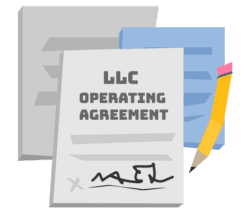
To update your Texas LLC’s Certificate of Formation, you’ll file a Certificate of Amendment with the Texas Secretary of State. Texas charges a $150 fee for filing a Certificate of Amendment, which can be done by mail, in person, or online. Learn everything you need to know about filing a Texas LLC Certificate of Amendment in our free guide.
In this article, we’ll cover:

When you start your Texas LLC by filing a Certificate of Formation, you register information about your company with the Texas Secretary of State. As time goes by and your LLC grows, you may need to update that registered information on state records about the business. Most of those changes can be done by filing Form 424 – Certificate of Amendment.
A Texas LLC files a Certificate of Amendment when its name is changed or its management structure needs to be updated. For example, file a Certificate of Amendment if your LLC goes from member-managed to manager-managed, or if individual member or manager information has changed. You can also file a Certificate of Amendment if you need to update any information that was provided (assuming you chose the option to add supplemental information or provisions on your LLC’s Certificate of Formation).
If you need to change your registered agent information, you can do it with a Certificate of Amendment, but unless you’re also updating other information at the same time, it’s much cheaper to simply file a $15 Form 401 – General Information (Change of Registered Agent/Office) instead.
Technically, you can submit a Restated Certificate of Formation form with rewritten articles (basically redoing your entire original Certificate of Formation) instead of filing an amendment—if you want to pay a $300 fee. Filing a Certificate of Amendment is a more affordable choice.
No, if an error made it into your LLC’s Certificate of Formation, you shouldn’t file a Certificate of Amendment. You’ll want to file a Certificate of Correction instead. Certificates of Correction allow you to identify errors or other items to be corrected, and usually make those corrections retroactively effective to when the Certificate of Formation was filed. Of course, if you want to make changes that negatively affect someone involved in your business, you’ll probably run into trouble.
Certificates of Correction can be filed by mail or in person for $15.
Need help with filing a Certificate of Amendment for your Texas LLC? Sign up for a free account with Northwest Registered Agent today and get access to our library of business forms.
No matter what you’re changing by amending your Certificate of Formation, you’ll need to include the following company information on your Certificate of Amendment form:
In addition, you will need to include a dated signature from a person who is authorized to act on behalf of your LLC.
In the Amendments section, you can update Article 1 (entity name) and Article 2 (registered agent) of your Certificate of Formation:
In the third Amendments section (Other Added, Altered or Deleted Provisions), you can do any of the following:
If there is not enough space on the form to include all your changes, you can include those provisions as an attachment.
You may file a printed Certificate of Amendment Form in person or by mail or upload a digital form online through the Secretary of State’s SOSUpload service. When you submit a printed form, you will need to include a duplicate copy.
Mail filings:
Secretary of State
P.O. Box 13697
Austin, TX 78711-3697
In-person filings:
James Earl Rudder Office Building
1019 Brazos
Austin, TX 78701
If all you need to amend is your LLC’s name, you can do that directly through the Secretary of State’s primary online service, SOSDirect. You’ll need to register an SOSDirect account to use either online method.
It costs $150 to file your Texas Certificate of Amendment. You can pay an additional $25 for expedited service. You’ll have to include a cover letter stating you want expedited processing.
Standard processing for a full Texas Certificate of Amendment normally takes approximately 3-5 business days after the Secretary of State receives the form, but processing time vary based on workloads, sometimes as long as 72 business days for paper forms. Expedited paper documents are processed within 14 business days.
When filing online, uploaded forms are processed in 13-15 days, and name change amendments are processed within 12 days.

Our guide to filing your Texas LLC’s annual tax report.

Set the rules for a Texas LLC with this important document.

All about getting an assumed name for your Texas business.

Learn how to change your Texas registered agent.

Closing up shop? Here’s how to wind your Texas LLC down.

Want to bring your Texas LLC back to life? Use our guide.